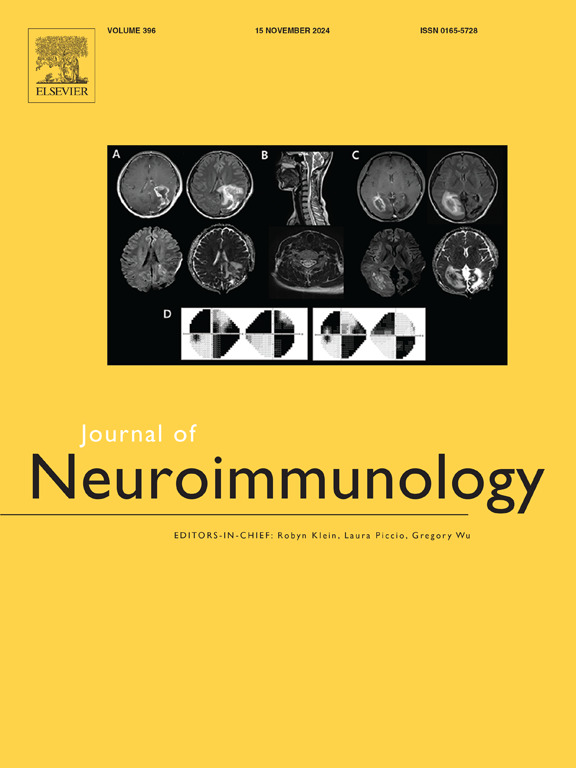MOGAD optic neuritis after mild head/orbital trauma in six children
IF 2.9
4区 医学
Q3 IMMUNOLOGY
引用次数: 0
Abstract
Myelin oligodendrocyte glycoprotein antibody-associated disease (MOGAD) is a potential cause of optic neuritis (ON). Its triggers and etiologies are not completely understood. We describe a novel clinical observation in six young patients with MOGAD-ON in the setting of strikingly parallel histories of mild head/orbital trauma. This is a single-center retrospective case series of six young patients and age-matched isolated MOGAD-ON controls. We present data both individually (de-identified, only the six trauma-associated cases) and in aggregate. Averages are presented as the arithmetic mean +/− SEM. 6/27 patients with MOGAD-ON, (3/6 female), between 8 and 18 years old presented with ON 5.5 days after mild head trauma. Four patients developed ON ipsilateral to their unilateral head trauma while two developed bilateral ON following midline head trauma. All patients tested positive for serum anti-MOG antibodies upon ON workup. They all received intravenous corticosteroids with rapid improvement in symptoms (5.5 weeks to full visual recovery) and none have since relapsed. No other patients with MOGAD-ON experienced preceding head trauma, and all patients in the control group were asked about trauma upon assessment of the history. Head trauma may serve as an inciting event in the presentation and diagnosis of MOGAD-ON. This novel observation provides a potential pathophysiologic mechanism independent of infectious triggers, although we cannot determine if these patients were already predisposed towards MOGAD-ON.
6例儿童轻度头/眶外伤后MOGAD视神经炎
髓鞘少突胶质细胞糖蛋白抗体相关疾病(MOGAD)是视神经炎(ON)的潜在病因。其诱因和病因尚不完全清楚。我们描述了一项新的临床观察,在6名年轻的加迪加- on患者中,他们的轻度头部/眼窝创伤史惊人地相似。这是一个单中心回顾性病例系列,包括6名年轻患者和年龄匹配的孤立摩加迪沙对照组。我们提供的数据既单独(去识别,只有六个创伤相关的情况下)和总体。平均值表示为算术平均值+/ - SEM。6/27名服用摩加迪沙-ON的患者(3/6为女性),年龄在8至18岁之间,在轻度头部创伤后5.5天出现ON。4例患者在单侧颅脑外伤后出现同侧ON, 2例患者在颅脑中线外伤后出现双侧ON。经ON检查,所有患者血清抗mog抗体均呈阳性。他们都接受了静脉注射皮质类固醇,症状迅速改善(5.5周至完全恢复视力),此后没有复发。没有其他使用摩加迪加- on的患者之前有过头部创伤,对照组的所有患者在评估病史时都被问及创伤情况。头部外伤可作为摩加迪沙- on的表现和诊断的一个刺激事件。这一新的观察结果提供了一种独立于感染诱因的潜在病理生理机制,尽管我们不能确定这些患者是否已经倾向于使用摩加迪加- on。
本文章由计算机程序翻译,如有差异,请以英文原文为准。
求助全文
约1分钟内获得全文
求助全文
来源期刊

Journal of neuroimmunology
医学-免疫学
CiteScore
6.10
自引率
3.00%
发文量
154
审稿时长
37 days
期刊介绍:
The Journal of Neuroimmunology affords a forum for the publication of works applying immunologic methodology to the furtherance of the neurological sciences. Studies on all branches of the neurosciences, particularly fundamental and applied neurobiology, neurology, neuropathology, neurochemistry, neurovirology, neuroendocrinology, neuromuscular research, neuropharmacology and psychology, which involve either immunologic methodology (e.g. immunocytochemistry) or fundamental immunology (e.g. antibody and lymphocyte assays), are considered for publication.
 求助内容:
求助内容: 应助结果提醒方式:
应助结果提醒方式:


